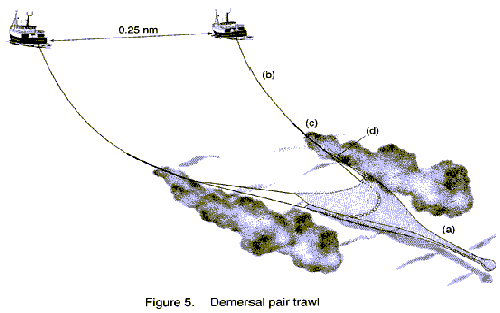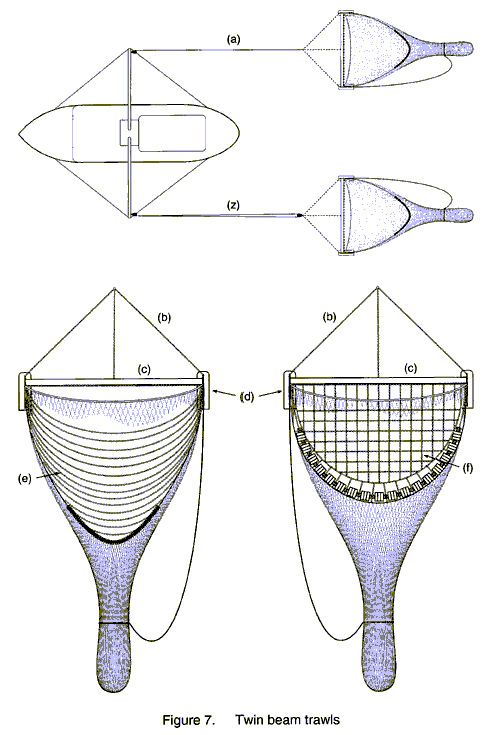|
Demersal Pair Trawl
2.4
In two-boat or pair demersal trawling (Figure 5) each vessel tows only one warp and by keeping station at a set distance apart (0.2-0.3 nautical miles) provides the horizontal forces required to spread the gear, rendering the need for otterboards unnecessary. This means that two vessels of relatively modest engine power can between them tow a comparatively large trawl, increasing between 50% to 100% the volume of water swept per vessel. Shackled between warps (b) and bridles (d) a heavy wire sweep (c) ensures good bottom contact. In all other respects the net (a) is similar to a single boat trawl, with floats and heavy rockhopper groundrope providing the vertical forces around the net mouth. Warp length/water depth ratio is around 3:1 with activity confined mainly to the continental shelf (200m). Heavy sweep wire lengths can range from 100 to 400 metres, depending on bottom conditions and vessel capabilities. Towing speeds between 2.5-4.0 knots can be encountered, with around 2.8 knots the norm.
Typical (and maximum) values for above components:- Trawl warp (b) wire diameter 21mm (24mm); Heavy sweep (c) wire diameter 26mm (30mm); Bridles (d) wire diameter 20mm or 16mm chain (19mm chain).
Twin Beam Trawling
2.7
Beam trawls are used to harvest whitefish, mainly flatfish such as sole, plaice or megrim together with angler and other species found hard down on the sea bed. Each net is fished from an outrigger boom, one on each side of the vessel (Figure 7), and towed from here on a single warp (a) shackled to a three chain bridle (b) attached directly to the beam (c) which holds open the mouth of the trawl. The beam, 9-12m in length, is constructed from heavy steel tube and supported on each side by rugged steel trawlheads (d) which slide over the sea bottom. Ahead of each groundrope tickler chains (e) or chain mats are often used to disturb fish, causing them to rise up and be taken by the trawl following immediately behind. Towing speeds are generally higher than otter trawling, reaching 6 or 7 knots on clean ground with ticklers, whereas on rough ground stone mats are towed at 4 knots. On the most powerful modern beam trawlers the weight of each fully rigged beam is almost 10 tons. Furthermore such vessels can tow this gear at 7 knots. Beamers usually operate on the continental shelf (200m) with warp length/water depth ratios of between 2.5 or 3:1. Some vessels have switched to a double wire system (z) to facilitate the hauling procedure, and consequently impose a doubling of the load applied to an obstruction before warp failure may occur.
Typical (and maximum) values for above components: Trawl warp single (a) wire diameter 26mm (34mm), double (z) wire diameter 24mm (26mm); Chain bridles (b) 19mm diameter mid-link (22mm); Assembled trawl weight (c+d+e) = 7.5 tonnes (10 tonnes).
http://www.scotland.gov.uk/library3/fisheries/figoo-02.asp
|

